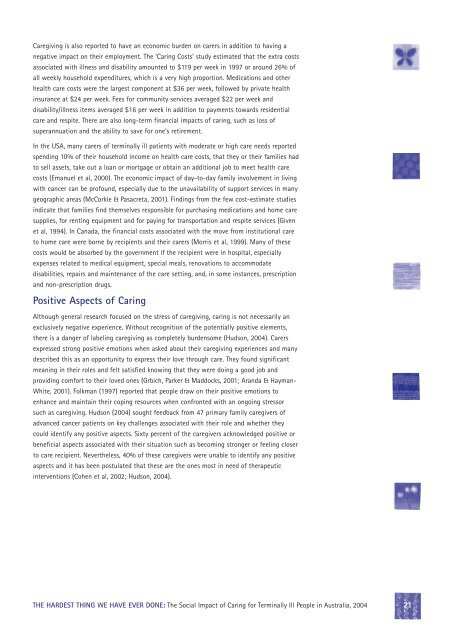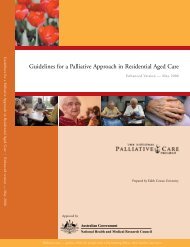The hardest thing we have ever done - Palliative Care Australia
The hardest thing we have ever done - Palliative Care Australia
The hardest thing we have ever done - Palliative Care Australia
You also want an ePaper? Increase the reach of your titles
YUMPU automatically turns print PDFs into web optimized ePapers that Google loves.
<strong>Care</strong>giving is also reported to <strong>have</strong> an economic burden on carers in addition to having a<br />
negative impact on their employment. <strong>The</strong> ‘Caring Costs’ study estimated that the extra costs<br />
associated with illness and disability amounted to $119 per <strong>we</strong>ek in 1997 or around 26% of<br />
all <strong>we</strong>ekly household expenditures, which is a very high proportion. Medications and other<br />
health care costs <strong>we</strong>re the largest component at $36 per <strong>we</strong>ek, follo<strong>we</strong>d by private health<br />
insurance at $24 per <strong>we</strong>ek. Fees for community services averaged $22 per <strong>we</strong>ek and<br />
disability/illness items averaged $16 per <strong>we</strong>ek in addition to payments towards residential<br />
care and respite. <strong>The</strong>re are also long-term financial impacts of caring, such as loss of<br />
superannuation and the ability to save for one’s retirement.<br />
In the USA, many carers of terminally ill patients with moderate or high care needs reported<br />
spending 10% of their household income on health care costs, that they or their families had<br />
to sell assets, take out a loan or mortgage or obtain an additional job to meet health care<br />
costs (Emanuel et al, 2000). <strong>The</strong> economic impact of day-to-day family involvement in living<br />
with cancer can be profound, especially due to the unavailability of support services in many<br />
geographic areas (McCorkle & Pasacreta, 2001). Findings from the few cost-estimate studies<br />
indicate that families find themselves responsible for purchasing medications and home care<br />
supplies, for renting equipment and for paying for transportation and respite services (Given<br />
et al, 1994). In Canada, the financial costs associated with the move from institutional care<br />
to home care <strong>we</strong>re borne by recipients and their carers (Morris et al, 1999). Many of these<br />
costs would be absorbed by the government if the recipient <strong>we</strong>re in hospital, especially<br />
expenses related to medical equipment, special meals, renovations to accommodate<br />
disabilities, repairs and maintenance of the care setting, and, in some instances, prescription<br />
and non-prescription drugs.<br />
Positive Aspects of Caring<br />
Although general research focused on the stress of caregiving, caring is not necessarily an<br />
exclusively negative experience. Without recognition of the potentially positive elements,<br />
there is a danger of labeling caregiving as completely burdensome (Hudson, 2004). <strong>Care</strong>rs<br />
expressed strong positive emotions when asked about their caregiving experiences and many<br />
described this as an opportunity to express their love through care. <strong>The</strong>y found significant<br />
meaning in their roles and felt satisfied knowing that they <strong>we</strong>re doing a good job and<br />
providing comfort to their loved ones (Grbich, Parker & Maddocks, 2001; Aranda & Hayman-<br />
White, 2001). Folkman (1997) reported that people draw on their positive emotions to<br />
enhance and maintain their coping resources when confronted with an ongoing stressor<br />
such as caregiving. Hudson (2004) sought feedback from 47 primary family caregivers of<br />
advanced cancer patients on key challenges associated with their role and whether they<br />
could identify any positive aspects. Sixty percent of the caregivers acknowledged positive or<br />
beneficial aspects associated with their situation such as becoming stronger or feeling closer<br />
to care recipient. N<strong>ever</strong>theless, 40% of these caregivers <strong>we</strong>re unable to identify any positive<br />
aspects and it has been postulated that these are the ones most in need of therapeutic<br />
interventions (Cohen et al, 2002; Hudson, 2004).<br />
THE HARDEST THING WE HAVE EVER DONE: <strong>The</strong> Social Impact of Caring for Terminally Ill People in <strong>Australia</strong>, 2004<br />
21
















